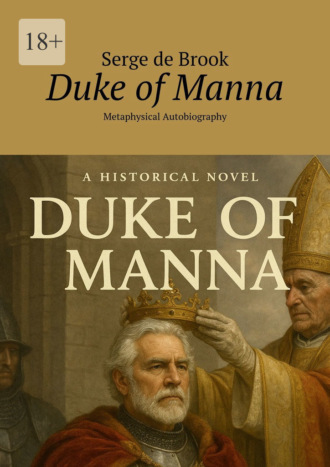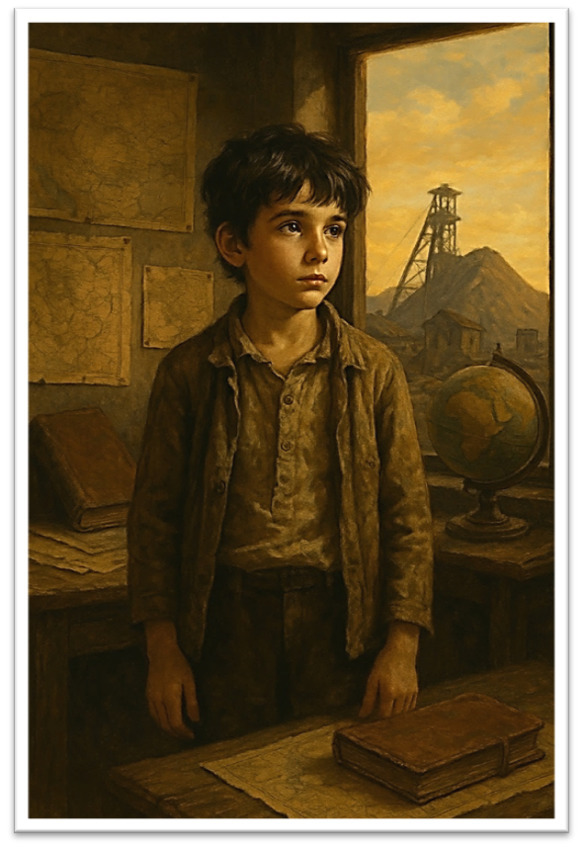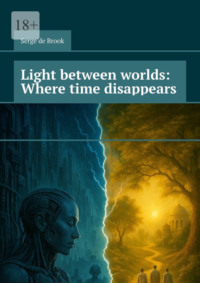
Полная версия
Duke of Manna. Metaphysical Autobiography

Duke of Manna
Metaphysical Autobiography
Serge de Brook
© Serge de Brook, 2025
ISBN 978-5-0067-4407-3
Created with Ridero smart publishing system
«DUKE OF MANNA»
Author: Serge De Brook
PROLOGUE: IMMERSION
Night. The city of Rome.
The Papal Library, a secret wing that can only be entered by a combination of an ancient prayer and the DNA seal of the sacred key keeper. Inside, only one lamp burns above a marble circle lined with symbols of Time.
Jan Kowalski stands in the center of the circle.
The Elder Priest of the Sovereign Order of St. John pronounces:
– When the spirit is ready, time recedes. Show the seeds of the stars, the roots of truth, O Gate of Chronos.
He touches Jan’s forehead. Light.
A noise like the sound of blood in the ears. Time crumbles. A series of images, voices, fire, gold, the rust of old blades.
First Vision: Jan is a young prince, son of King Manna. 1113 BC.
The Order is in its infancy.
Jan is studying under the guidance of the Brother Master, but doubts fight within him.
He is called to duty, but he turns away.
He will die in a duel for the throne, leaving no descendants.
The glimmer of sunset. Jan stands on the circle.
The priest quietly says:
– You have already made mistakes. Now it is time to create.
The images of the mine waste heaps around his city on Ukrainian soil, his father in the mine, his mother with bread, the train station in Kharkov washed over him.
He returns. With knowledge. With a vision.
With a question: who was my path really?
Thus begins a story in which memory becomes a plan, faith – a weapon, and life – a battlefield for the future.
Jan Kowalski, no longer just a representative of the African branch of the Trust, but the heir to the forgotten line of the kings of Manna, felt the weight of the burden of centuries falling on his shoulders.
The visions that pierced his consciousness did not simply show him a past life, they revealed the secret of the Order of St. John – not just the keepers of history, but active participants in its formation.
His past, his death in a duel for the crown, is not the end, but only a turning point in an endless spiral of time.
Now, standing on the marble circle, Ian realizes his mission – to prevent a catastrophe that threatens the entire planet.
The images of his hometown in Donbass, his father working in the mine, his mother who always took care of the family – this is not just nostalgia, but keys to a solution.
They contain the power to resist the forces of darkness that manipulate the course of history.
He sees a connection between his past, the forgotten kingdom of Manna and modern geopolitics.
An ancient civilization possessed technologies that could influence time, and their secrets, hidden in the symbolism of the circle and ancient prayers, became the target of many enemies.
The priest, the oldest of the Order, begins to initiate Ian into the secrets of time manipulation.
explains that visions are not just memories, but maps that show the way to changing the past and saving the future.
Jan learns to control the flows of energy contained in the symbols on the circle, immersing himself in meditative practices reminiscent of the rituals of the priests of Manna.
During the ritual, he instantly studies ancient manuscripts, deciphering encrypted messages that reveal strategies for combating the enemies of the Order – the secret society «Children of Anubis», thirsty for control over time to achieve world domination.
The Elder, during a regressive ritual, sends him on a journey, following the trail of the ancient civilization of Manna.
Jan visits lost temples in the mountains of Azerbaijan and Iran, studies ancient Egyptian papyri, finding evidence of the connection between Manna, Egypt and Russia – a center that, as he begins to understand, played a key role in the balance of time flows.
He meets other members of the Order – historians, cryptographers, philosophers, each of whom contributes to his preparation.
He learns not only to control time, but also to resist time manipulators, realizing that changing the past can have unpredictable consequences.
Jan is not alone on this path. Jan and Jasper conduct research and come to unexpected discoveries that link the secrets of Manna with modern technology and global events.
History becomes not just a set of facts, but a dynamic system where every action has far-reaching consequences.
Jan understands that his path is not only to save the world, but also to find himself, to understand his present through the prism of the past.
His struggle is not for a crown, but for the very essence of time and the future of humanity.
In the tapestry of life, woven from the threads of fate and choice, in Jan’s regressive vision, a figure appears whose path is marked by purpose and illuminated by divine light.
«The Duke of Manna» is not just a title, but a testimony to a journey that goes beyond time and space, revealing the essence of the soul, connected to service to the Creator.
Born in the land of Ukraine, amidst the whispers of ancient forests and the echoes of forgotten legends, a young man found himself drawn to a calling that echoed in the chambers of his heart.
His search for truth and meaning led him on a pilgrimage of the soul, where he discovered the timeless wisdom that guided his steps on the path of the Warrior of Light.
Through trials and tribulations, victories and defeats, he remained steadfast in his devotion to the fundamental principles of life – a beacon of light in a world shrouded in darkness.
It was his unwavering commitment to serving God Almighty, the Father Almighty, the Creator of all that is, that earned him the honorary title of Duke – a symbol of honor and reverence for his unwavering faith and devotion.
For he understood that in the vast expanses of existence, beyond the veil of illusion and shadow, lies the Source of all and everything – the Breath of Love and Light that sustains the cosmos.
In his journey, he sought to embody this divine essence, to become a vessel of grace and compassion in a world yearning for salvation.
As you read this autobiographical novel of conspiracy, let the story of the Duke of Manna be a reminder that within each of us lies the potential to illuminate the darkness, uphold the virtues of truth and righteousness, and follow in the footsteps of those who serve the highest purpose of existence.
Let his story inspire you to awaken the Warrior of Light within you and embrace the eternal flame of love and light that guides us all along the path to divine realization.
CONTENTS:
PART 1. THE COVENT OF MEMORY
Chapter One – The WHISPER OF DESTINY
Chapter Summary
In the austere heartlands of Donbass, beneath low-hanging skies and upon coal-blackened soil, a boy was born whose name would one day echo across the realms of the spirit and history alike – Jan Kowalsky.
His youth unfolded amidst the clangour of steel, the hum of conveyor belts, and the quiet endurance of men who descended daily into the womb of the earth.

Jan Kowalsky was a boy born on the wide plains of Donbass, a land steeped in history and destiny – a place where the sky hung low and the soil was black as anthracite.
Donbass: a harsh realm of coal, mines, and labouring honour.
His father, Vladimir, was a miner – a quiet man, yet full of inner strength. Each day he descended into the earth before dawn and returned home only after the sun had vanished behind the silhouettes of slag heaps.
His hands were always covered in coal dust, but in his eyes lived a warm, steady love for his family.
His mother, Nadezhda, worked in a grocery store. Her care, tenderness, and nightly prayers created a space of warmth and stability in their home.
From early childhood, a fire burned in Jan’s heart – an insatiable longing for knowledge and adventure.
He dreamed of faraway lands, of meeting distant cultures, and bringing the light of change into the world.
He spent countless hours in the library, immersed in books about oceans, jungles, mountains, and pioneers.
The tales of Jules Verne, Jack London, and explorers of the Amazon and the Arctic set his imagination ablaze.
His room became a private museum of dreams.
Maps of the world hung on the walls, along with cut-out photos from magazines and notes pinned like sacred totems.
Each point on a map became a symbol – a destination he vowed to reach.
A true revelation came one day in his grandmother’s attic: a worn leather journal belonging to his great-great-grandfather Maxim, a geologist who had explored Siberia in the early 20th century.
Inside were vivid accounts of life in the taiga, descriptions of the haunting «Phantom Valley,» and a pressed violet flower tucked beside a hand-drawn map.
That valley became for Jan not just a geographic mystery, but a symbol of his inner, spiritual calling.
He began researching, asking historians, drawing new maps of future expeditions.
His parents – hardworking and humble – were slow to accept his dreams; they longed for him to choose a stable life.
But Jan had always known his path was different.
He started learning languages – first English, then even Swahili, strange to his surroundings.
He watched films, studied from old manuals, and imagined a life shaped by exploration.
His first great step came with a journey to Leningrad a bold move for a teenager.
But it was there, by the Baltic Sea, that Jan realized his dream was not a fantasy. It was a calling he could not ignore.
Jan Kowalski was a boy born in the vastness of Donbass, a land steeped in history and destiny, in a city where the sky was low and the earth was as black as anthracite.
Donbass is a harsh land of coal, mines and labour valour.
His father, Vladimir, was a miner – a man of few words, but full of inner strength.
He went underground every day before dark and returned home when the sun had already disappeared behind the line of waste heaps.
His hands were always covered in coal dust, but his eyes dwelt with a warm, calm love for his family.
His mother, Nadezhda, worked in a grocery store.
Her care, tenderness and daily home prayer formed a space of comfort and support in the house.
From childhood, the fire of an unquenchable desire for knowledge and travel burned in Jan’s heart.
He dreamed of seeing distant lands, getting to know other cultures and bringing the light of change to people’s lives.
He spent hours in the library, immersed in books about seas, mountains, jungles and explorers.
The stories of Jules Verne, London, the conquerors of the Amazon and the Arctic fired his imagination.
Jan’s room gradually turned into a personal museum of dreams. Geographical maps, photographs of exotic places, pages with magazine clippings hung on the walls.
Each point on the map became a symbol for him – a goal that he would one day achieve.
A real revelation for him was the discovery in his grandmother’s attic: an old leather diary of his great-great-grandfather Maxim, a geologist who explored Siberia at the beginning of the 20th century.
His descriptions of Siberian nature, life in the taiga and the mysterious «Ghost Valley» deeply touched Jan.
A map with this name and a dried purple flower were enclosed in the diary. «The Phantom Valley» became a symbol for Jan not only of geographical exploration, but also of inner, spiritual purpose.
He began to collect information, question historians, and make a map of his future discoveries.
His parents, simple workers, did not immediately accept his dreams – they wanted their son to find stability.
But Jan felt from an early age that his path was different.
He began to study languages – first English, then even Swahili, which was exotic for his environment.
He watched films, studied using self-study guides, dreaming of a life full of discoveries.
His first big step was an independent trip to Leningrad.
It was a bold decision for a teenager, but it was there, by the Baltic Sea, that he realized that his dream was not an illusion, but a path that he had to take. Jan spent hours in the library, reading books about travel.
Yellow pages, covered with exciting stories of explorers, sailors and discoverers, excited his imagination.
He studied maps, marking the routes of famous expeditions on them, imagining himself in the place of the great pioneers, feeling the wind in his face and the sun on his skin.
His room turned into a kind of museum: the walls were hung with photographs from geographical atlases, and the table was covered with maps, guidebooks and notes.
He dreamed not just of seeing the world, but of understanding it, of being imbued with its spirit, of feeling the pulse of each culture, of absorbing the diversity of languages and traditions.
Jan, with his dishevelled brown hair, always stained with soot from endless games in the ruins of the old factory, dreamed not of comfort, but of a storm of emotions.
His old, tattered geographical map of the world, hanging above his bed, was pretty worn out from numerous touches of his fingers.
Each country, each city, marked by him with a pencil, were not just abstract dots on paper, but entire worlds, full of mysteries and secrets, waiting for their explorer.
He spent hours in the local library, reading books about the travels of Jules Verne, Jack London, about the conquerors of the Amazon and explorers of Antarctica.
These stories, full of dangers and discoveries, kindled a fire of restlessness in his heart, made his heart beat faster.
He imagined himself as a fearless explorer, blazing new trails, overcoming incredible challenges and discovering new, uncharted lands.
One day, while rummaging through the dusty attic of his grandmother’s house, Jan found an old, worn leather diary.
Its yellowed pages, written in uneven handwriting, told the story of his great-great-grandfather, Maxim, a geologist who led expeditions across Siberia at the beginning of the last century.
Maxim described the beauty of untouched nature, the harsh living conditions in the taiga, meetings with locals and the amazing discoveries he made during his research.
The diary was like a message from the past, confirmation that his dreams were not so impossible.
At the end of the diary was a dried flower, an unusual purple colour, with a subtle, barely perceptible aroma, and a mysterious, not fully deciphered map depicting an abandoned mining village, «Ghost Valley», lost in the Siberian taiga.
The discovery of the diary was a real shock for Jan.
Now his desire to travel was reinforced by a family legend, a mystery that he was obliged to solve.
«Ghost Valley», plotted on the map with uneven lines, became for him not just a geographical object, but a symbol of his destiny, a key to discovering not only geographical, but also family secrets.
He began to collect information about the «Ghost Valley», study old newspaper clippings, consult with local historians.
Gradually, from disparate facts, the history of the abandoned village emerged, a story about the misfortunes that befell its inhabitants, about lost treasures and about the mysterious circumstances of people’s disappearances.
Every detail he found, every word in his great-grandfather’s diary, confirmed Yan’s decision to go on an expedition.
He realized that the journey to the «Ghost Valley» would not just be an adventure, but also a search for himself, his roots and his place in this world.
And the dried flower became his talisman, reminding him that even the most forgotten corner of the earth has its own beauty and secrets waiting for its explorer.
Gorlovka, with its grey five-story buildings and coal mines, seemed to Yan only a temporary stop on the way to his great dream.
He often sat on a hill on the outskirts of the city, looking at the sunset, and imagined himself on the shore of an exotic island, among snow-white beaches and azure waters.
Or in the heart of the Amazon jungle, among impenetrable thickets and wild animals. Each image in his imagination was so vivid and bright that it was almost tangible.
His parents, simple workers, did not always understand his aspirations.
They saw a more prosaic future for him: a stable job in the mine, a family, a home.
But Jan stubbornly insisted on his own.
He convinced them that his dream was not just a whim, but a life goal that he would follow at all costs.
He knew that the path would be long and difficult, that he would have to overcome many obstacles and trials. But he was ready.
He began preparing by studying languages.
First English, then he decided on an African language – Swahili.
Each new word, each new phrase brought him closer to his cherished goal.
He studied in the city library using self-study guides, watched films and TV series in foreign languages.
At the same time, he studied hard at school, trying to get good grades in order to enter the university for a specialty that would help him in his future travels.

The first serious step was his first trip and escape from home, a trip to the city of Leningrad – the cradle of naval glory.
For Jan, this was a real adventure.
It was his first time traveling on his own, his first time in a new environment, his first time feeling truly independent.
This journey became a symbol of his readiness for greater conquests. Jan returned home with his eyes glowing with impressions and a firm belief that his dream would not remain just a dream.
Chapter Two – THROUGH THE DUST OF EMPIRE
«History is not a collection of dates and battles – it is the voice of forgotten souls echoing through time.» – Sir Richard Evelyn, On the Nature of Memory (1897)
Chapter Summary
Jan Kowalsky begins his journey into the Soviet military structure. Through gruelling training and covert assignments, he uncovers the dual face of the empire: disciplined on the surface, but crumbling within.
The seeds of doubt are planted – and a deeper mission begins to stir within him.
Jan arrived at the military enlistment office with a silence honed from his youth.
His papers were in order, his uniform pressed, his mind focused.
But beneath his stoic bearing, questions stirred – not about duty, but about truth.
Assigned to a border division in Central Asia, he soon discovered that service in the Red Army was more than drills and protocol.
It was endurance, suspicion, codes spoken without words.
The terrain itself seemed to conspire against them – brutal summers, dust storms that swallowed men whole, and ancient villages clinging to the edges of empire.
At the age of fourteen, Jan made his first conscious choice – he left his hometown and headed to Kharkov.
The decision was dictated by a dream: to become an oceanographer.
Not a captain, not a navigator, but a scientist – an explorer of the underwater depths, a silent and mysterious world.
He was attracted to the waters not as an escape, but as a space of truth. The water called him to itself.
In Kharkov, he entered a technical school where they studied the basics of hydrography, geophysics and marine biology.
Among the old Soviet buildings and laboratories, among the green alleys of the student campus, he felt for the first time that he belonged to something greater.
There were people like him – young dreamers with eyes fixed on the horizon.
There he learned discipline, the scientific method, and research patience.
During this same period, Jan began to think about the essence of his attraction to the sea.
Sometimes in the evenings he would sit on the roof of the dorm and look at the stars, feeling that it was not just the ocean that was calling him, but something as ancient as the earth itself.
He could feel the breath of the elements, as if they were alive.
His interest in the oceans was heightened by his studies, but at the same time, anxiety was born within him.
The underwater world no longer seemed to him simply a sphere of science.
He was beginning to understand: behind the layer of water, behind the thickness of the tectonic plates, there was not only nature, but also history. The history of mankind, hidden under layers of time.
One day, while doing an internship on a hydrographic vessel, he stood at the side, looking at the depth chart.
At that moment, for the first time, he felt a faint but distinct voice inside himself:
«You are looking below for what you have lost above.»
This was a turning point.
He realized: the ocean was a metaphor.
His true path was not in the water, but in the very essence of knowledge. In memory. In Truth.

In Kharkov, he met his first love and faithful friend for life, Irene.
Their bond was strong and unwavering; their friendship carried through the years and trials.
Together they shared joys and sorrows, supporting each other in difficult moments and celebrating ecstatic successes.
Jan and Irene became not only lovers, but also partners in business.
Their passion for research and desire to change for the better led them to new heights.
They became warriors of light, fighters for good and harmony in the world, where every step was aimed at creating a better future for everyone.
Their path was strewn with challenges and trials, but they overcame all obstacles together, holding hands and moving forward, no matter what.
Their joint efforts bore fruit, making changes where it was especially needed, and leaving traces of light where darkness reigned.
Jan and Irene continued their journey through life, bringing light and hope to every corner of the world, where their kindness and compassion helped those who needed support and understanding.
Jan proved himself quickly – not by shouting orders, but by quiet efficiency. He read situations before they unfolded.
He listened.
He moved like someone with a second sight.
It wasn’t long before a man in a long coat from the capital took notice.
The assignment came sealed.
Its contents were simple: Transfer to a unit operating outside of standard jurisdiction. Location: Afghanistan. Role: interpreter, observer, neutral presence.
He boarded a military transport at dusk.
As the engines roared to life, Jan glanced once more at the twilight behind him – not to say farewell, but to confirm: this was only the beginning.
Kabul was not a battlefield when he arrived – not yet.
It was a chessboard.
Allies were uncertain, enemies wore no uniforms.
His orders were to watch.
To report. To disappear into the shadow of geopolitics.
But it was there, under Afghan stars, that the Order whispered again.
In an ancient bookstall tucked behind a mosque in Mazar-i-Sharif, Jan found a volume wrapped in lambskin, written in three scripts – Arabic, Latin, and something older.
The vendor claimed it had been smuggled out of Samarkand before the Revolution.
The final page bore a symbol he had seen only once before – in the attic of his grandmother’s house.
The spiral. The sword. The sun.
Their story became a legend, inspiring others to follow their hearts and strive for a better world that needed warriors of light like them.
In college, Jan tried to master the knowledge of his chosen profession as an oceanographer and at the same time diligently engaged in sports.
His passion for travel led to cycling.




